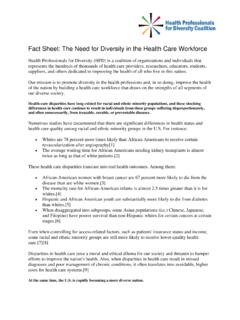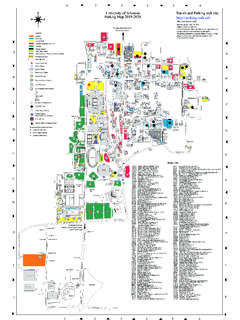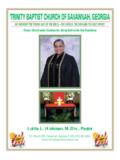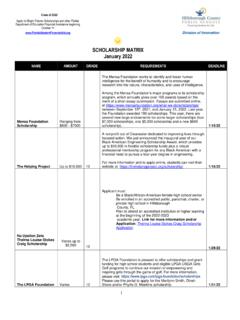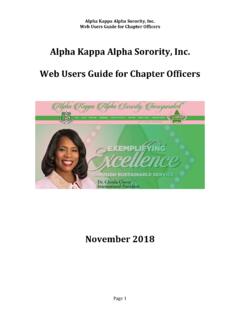Transcription of Making Community PartnershipsWork: A Toolkit
1 Making Community Partnerships Work:A ToolkitThis document was developed as a result of the Genetic Education Needs Evaluation (GENE)Project which was supported by grant U33 MC 00157 from the Department of Health and HumanServices, Health Resources and Services Administration (HRSA), Maternal and Child Health Bureau,Genetic Services Branch. Partners in the project included HRSA, March of Dimes, Michigan GENEP roject, Washington Heights/Inwood GENE Coalition, Genetic Alliance and Family Voices. March of Dimes Foundation would like to thank the many individuals who assisted in the development and production of this Toolkit . Author:Aida GiachelloEditors:Diane AshtonPenny Kyler EmyLou S.
2 RodriguezRenee ShankerAnn UmemotoPlain Language Reviewer:Wendy Mettger, Mettger CommunicationsMarch of Dimes would also like to thank the Community organizations that participated in the GENE have helped us to better understand how to make Community partnerships March of Dimes FoundationThe mission of the March of Dimes Foundation is to improve the health of babies by preventing birth defects, premature birth and infant mortality. Founded in 1938, the March of Dimes funds programs ofresearch, Community services, education and advocacy to save babies. For more information about birthdefects, genetics, family health history and newborn screening, visit Recommended CitationGiachello AL, author; Ashton D, Kyler P, Rodriguez ES, Shanker R, Umemoto A, eds.
3 2007. Making Community Partnerships Work: A Toolkit . White Plains, NY: March of Dimes InformationCopies of this Toolkit can be downloaded or ordered from the March of Dimes Web site at: ACKNOWLEDGMENTSC ontributors:Diane GrossDaniel KorinE. Yvonne LewisSteve O DonnellRosita RomeroJesus SanchezOthelia PryorWestchester Children s AssociationDesign:Jill Little, iDesignWashington Heights/Inwood GENE Coalition:Alianza DominicanaColumbia University Medical CenterCommunity Board 12 Community Health Alliance of Harlem and NorthernManhattan, Healthcare NetworkCUNY Dominican Studies InstituteDominican Women s Development Center Fort George Community Enrichment Center, PlusMama Tingo Cultural CenterNorthern Manhattan Perinatal Partnership, Romero of the Americas United Church of ChristYMHA & YWHA of Washington Heights/InwoodMichigan GENE Project Community Advisory Board.
4 alpha kappa alpha sorority , Inc. Lansing ChapterFaith Access to Community Economic DevelopmentGreater Lansing African American Health InstituteHueman BeeneMichigan State UniversityOmega Psi Phi Fraternity Lansing ChapterUrban League of LansingUrban League of FlintWoodcreek Elementary SchoolMaking Community Partnerships Work:A Toolkit iiiABOUT THIS Toolkit ..1 Background and Purpose .. 1 Intended Audience .. 1 Terms to Know.. 1 What s Inside .. 2 Overview of Sections .. 2 INTRODUCTION: What is a Community -Based Participatory Partnership?3 Stages of Community -Based Participatory Partnerships .. 3 Key Principles of Community -Based Participatory Partnerships.
5 4 Benefits of Community -Based Participatory Partnerships .. 5 Summary .. 5 STAGE 1: Getting Started Are You Ready for Community -Based Participatory Partnerships? Your Readiness for Community -Based Participatory Partnerships .. 6 Summary .. 7 Case Story: The Genetics Education Needs Evaluation (GENE) Project .. 8 STAGE 2: Moving Forward How to Approach and Involve Community the Community .. 9 What is a Community ? .. Your Homework: Get to Know the Community .. 10 Assess Community Strengths, Assets and Resources .. with Community Gatekeepers and Key Informants .. 11 Conducting Key Informant Interviews .. 12 Strategies for a Successful Key Informant Interview.
6 13 Case Story: Leveraging Existing Connections to Explore New Partnerships.. 16TA B L E O F C O N T E N T Dialogue: Meet the Community Stakeholders and Possible Partners .. 16 Elements of a Successful Community Meeting .. a Partnership Planning Group .. 20 Challenges and Solutions to Involving the Community .. 21 Case Story: Meeting with the GENE Project Community Partners.. 22 Summary .. 23 STAGE 3: Putting It All Together How to Formalize and Maintain a Community -Based Participatory Your Partnership .. 24 Types of Partnerships.. 24 Benefits of Forming a Coalition .. 25 Roles in a Partnership .. 25 Case Story: The Beginnings of the WH/I GENE Project Coalition.
7 A Partnership Identity and Purpose .. 27 Vision, Mission, Goals and Objectives.. 27 Case Story: Community Ownership .. 28 Group Name and Logo .. 29 Case Story: WH/I and MI GENE Project Group Identity.. Group Membership and Leadership .. 30 Recruiting and Maintaining Members .. 30 Group Leadership .. 31 Group Trust and Cohesiveness .. 34 Case Story: Group Trust in Flint/Lansing, MI .. Organizational Structures and Guidelines that Support the Partnership .. 35 Establish Group Rules and Structures .. 35 Case Story: WH/I GENE Coalition Executive and Standing Committees .. 37 Develop Systems for Communicating and Decision- Making .. 37 Case Story: Modified Consensus in Flint/Lansing, MI.
8 38TA B L E O F C O N T E N T SDevelop Partnership Guidelines .. 38 Case Story: The GENE Project Partnership Guidelines .. 40 Challenges and Solutions to Maintaining Community -Based Participatory Partnerships .. 40 Failure to Act.. 40 Limited Resources .. 40 Case Story: Clarifying Needs and Expectations in WH/I, NY .. 41 Group Dynamics .. 41 Power Relationships .. 41 Cultural Differences.. 42 Case Story: Embracing Diversity within the GENE Project.. 43 Sustainability .. 44 Case Story: Sustaining GENE Project Community Efforts .. 44 Finding Solutions.. 45 Regularly Evaluate Your Partnership .. 45 Summary .. 47 APPENDICES49 Appendix A:Terms to Know .. 49 Appendix B:Tools.
9 53B1 Sample Coalition Recruitment Flyer (English and Spanish).. 54-57B2 Sample Coalition Membership Form (English and Spanish) .. 58-59B3 Sample Coalition Meeting Evaluation Form (English and Spanish).. 60-61B4 Meeting Minutes Template .. 62B5 Sample Decision- Making Framework.. 63 Appendix C:References and Additional Resources .. 65-69TA B L E O F C O N T E N T Sv1 ABOUT THIS TOOLKITB ackground and Purpose Health researchers have shown that building effective communitypartnerships helps address the health and social needs of a partnerships allow agencies and Community members to jointogether to identify a common problem and to develop a plan of actionto address that problem (Israel, Eng, Schulz & Parker, 2005).
10 The actionplan might focus on prevention, education, advocacy or a researchprogram to look at the problem in greater Toolkit is based on the lessons learned from the national and Community partners involved in the Genetics Education Needs Evaluation(GENE) Project. The GENE Project was a 5-year program funded by theHealth Resources and Services Administration to investigate the geneticseducation needs of underserved, minority communities. March of Dimesand its national partners, Genetic Alliance and Family Voices, workedwith two communities to determine their cultural and language needs inthe area of genetics education and develop action plans to address thoseneeds.
